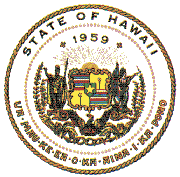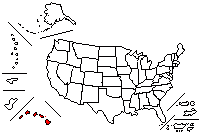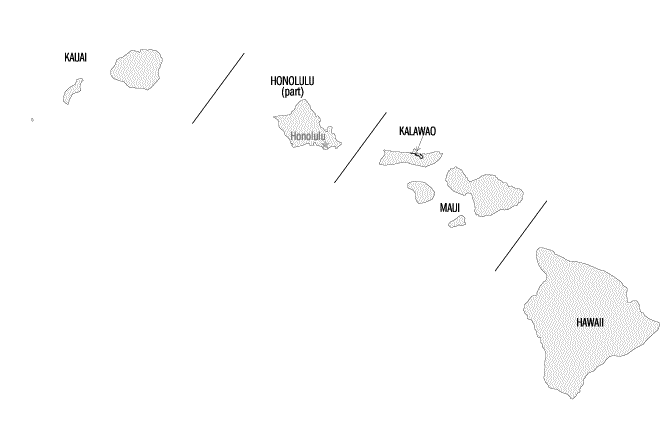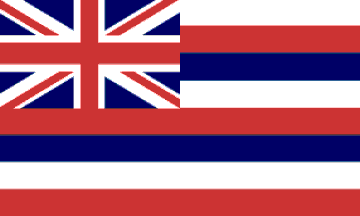
 |
|

















(Hawaiian)
Hawai`i Pono`i |
Hawaii es Nuestra |


Flag:
Hawaii was once an independent kingdom. (1810 - 1893)
The flag was designed at the request of King Kamehameha I. It has eight stripes of white,
red and blue that represent the eight main islands. The flag of Great Britain is emblazoned
in the upper left corner to honor Hawaii's friendship with the British.
The combination of the stripes of the United States flag and the Union
Jack of Great Britain is said to have pleased the merchant shippers of both nations.
Flag adopted for official state use in 1959.
The flag was designed by Colonel Charles Harris in 1911 while he was Adjutant General of the Territory.
Bandera:
Hawaii fué una vez un reino independiente (1810-1893).
La bandera fué diseñada a petición del Rey "Kamehameha I".
Tiene ocho rayas
en blanco, rojo y azul que representan las ocho islas principales. La bandera de Gran Bretaña
se encuentra en la parte superior izquierda en honor a la amistrad entre Hawaii y los Britanicos.
La combinacion de las rayas de la bandera de los Estados Unidos y la unión de la sota de Gran Bretaña,
se dice, que era para agradar a los barcos mercantes de ambas naciones.
La bandera fué adoptada oficialmente en el 1959.

Hawaii
Information: HERE
Capital City: Honolulu
Admission to Statehood: August 21, 1959
Motto: Ua mau ke ea o ka aina I ka pono -
The life of the land is perpetuated in righteousness.
Before becoming the state of
Hawaii’s official motto, these words were part of the coat of arms of the Kingdom of Hawaii
and the seals of the Republic of Hawaii and the Territory. King Kamehameha III issued this
motto upon the restoration of the Hawaiian flag to the kingdom by the British in 1843 after a
British admiral attempted a takeover in 1843.
National: Hawaiians
Nickname: Aloha State
Origin of state's name: Named by Hawaiian. Could be based on native Hawaiian word for homeland, "Owhyhee"
Language:
Hawaii's two official languages are Hawaiian and English.
The melodious Hawaiian language is a Polynesian dialect. There are only
13 letters in the Hawaiian alphabet: A, E, H, I K, L, M, N, O, P, U and W.
And 18 sounds a, e, i, o, u, ä, ë, ï, ö, ü, h, k, l, m, n, p, w, and w with a v
sound. The ‘okina (‘) is a glottal stop like the sound between the ohs in
"oh-oh" and is also a consonant. In order to clarify pronunciation, you will
often see the glottal stop ( ‘ ) or ‘okina and macron used on words such as Hawai‘i.
Hawaii (se pronuncia Ja-uá-ii en inglés)(Ja-uái en español)
Ciudad Capital: Honolulu (se pronuncia Jó-no-lu-lu en inglés)(O-no-lu-lú en español)
Información: AQUí
Admisión como Estado: 21 de agosto de 1959
Lema: Ua mau ke ea o ka aina I ka pono - La vida en la tierra se perpetúa en la Justicia.
Antes de que Hawaii se conviertiera en un estado de la Unión este lema era parte del escudo
de armas del Reino de Hawaii y del sello de la República de Hawaii y del Territorio. El Rey
Kamehameha III promulgó este lema por la restauración de la bandera de Hawaii por los Britanicos
en el 1843, después que un admirante Británico quiso cojer el poder en el 1843.
Gentilicio: Hawaianos (jauiaianos)
Cognómento: El estado del Aloha
Origen del Nombre: Nombre dado por Hawaianos. Pudo estar basado en la palabra hawaiana "Owhyhee".
Idioma:
Hawaii tiene dos idiomas oficiales que son el Hawaiano y el Inglés.
El idioma Hawaiano es un dialecto Polinesio. Solo hay 13 letras en el alfabeto Hawaiano:
A, E, H, I K, L, M, N, O, P, U y W. Y 18 sonidos que son: a, e, i, o, u, ä, ë, ï, ö, ü, h, k, l, m, n, p, w, y w con una v.


The Seal:
The seal of the state of Hawaii features a grand image of King Kamehameha I,
royally dressed and holding his staff, and a classic rendition of Liberty,
holding the Hawaiian flag, on either side of a heraldic shield. A Phoenix rises
up from native foliage. The date 1959, representing Hawaii's statehood, displays
prominently.Wording on the seal reads "State of Hawaii" across the top.
On the bottom of the seal is a quote attributed to King Kamehameha III,
after a British admiral attempted a takeover in 1843: "Ua mau ke ea o ka aina i ka pono",
translated as "The life of the land is perpetuated in righteousness."
El Sello:
El sello del estado de Hawaii presenta al imagen del gran Rey Kamehameha I (Kamejameja I)
vestido con toda su realeza y con porte de mando, una clasica representación de libertad,
sujetando la bandera de Hawaii y a su lado el escudo de armas. Un ave Fenix sube
sobre el nativo follaje. La fecha 1959, representa cuando Hawaii fué admitido como estado,
presentada prominentemente. Las palabras en el sello "Estado de Hawaii"
cruza en la parte superior. En la parte inferior cita una palabras
atribuida al Rey Kamehameha III,
después que un admirante británico intentó tomar el poder en 1843:
"Ua mau ke ea o ka aina i ka pono"
(La Vida en la tierra se perpetua en la Justicia).

HISTORY
Hawaii, the most recent state to be admitted to the United States,
is made up entirely of islands in the mid-Pacific Ocean.
The point closest to the mainland of the United States is
about 3,365 km (2,091 mi) southwest of San Francisco. A famous
tourist spot, Hawaii is called the Aloha State; aloha is an
expression of love or goodwill in the Hawaiian language. The
state has a mixed population, consisting primarily of persons of
Japanese, Filipino, Polynesian, and Chinese descent, as well as
Caucasians.
The first white men to visit the islands were probably Capt.
James Cook and his crews aboard the Resolution and Discovery,
in 1778. In 1898 the Hawaiian Islands were annexed by the United
States. American entry into World War II was precipitated by
the surprise Japanese attack (Dec. 7, 1941) on U.S. military
installations in and around Pearl Harbor, an inlet near Honolulu,
Hawaii's capital. Hawaii became the 50th state on Aug. 21, 1959.
Between AD 400 and 900, Polynesians from the Marquesas Islands and
Tahiti settled some of the Hawaiian Islands, having traveled across
the ocean in large sailing canoes. They established an economy
based on ahupuaa, land units that extended from mountaintop to the
sea. They had a hereditary ruling class, called the alii nui,
under which were the common people, primarily fishermen and farmers.
Religion was based on a belief in gods existing in all forces and
objects; a taboo, or kapu, system provided rules for maintaining
the political and social order.
Europeans may have visited present-day Hawaii as early as the 16th
century, but it was British naval officer Capt. James Cook who landed
at modern Waimea, on Kauai, in January 1778 and named the archipelago
the Sandwich Islands, in honor of the 4th earl Sandwich, then
head of the British Admiralty. Cook was killed by Hawaiians on a
return voyage in 1779, but foreigners soon began trading with the
islanders.
The Kamehameha Dynasty
U.S. Annexation and Statehood
When Cook visited, there were about 300,000 Hawaiians, divided into
several competing political units. After a ten-year war (1782-92)
Kamehameha I (see Kamehameha, dynasty gained control of Hawaii island
and by 1810 succeeded in unifying the archipelago, founding the
Kingdom of Hawaii. After 1810 white traders (many of whom were
Americans) were interested primarily in Hawaiian sandalwood, most
of which was shipped to China. The outside traders brought with them
several infectious diseases that killed many Hawaiians, resulting
in a steep population decline by the mid-1800s.
Kamehameha II, who succeeded to the throne in 1819, abolished the
Hawaiian religion shortly before the arrival (1820) of Protestant
missionaries from New England. These missionaries introduced not only
Christianity but Western education and the press. Opposition to
missionary-inspired laws caused considerable trouble, and when
Kamehameha III (r. 1825-54) succeeded to the throne many foreigners
took part in an attempted overthrow of the government.
An American missionary, William Richards, became a government
advisor, and with his assistance the government promulgated (1839)
the Declaration of Rights and the Edict of Toleration.
Not long afterward the first constitution was written. These
documents introduced many Western characteristics of government,
including legislative, executive, and judicial branches, and secure
personal and property rights. The greatest accomplishment of this
era was the Great Mahele, or division of lands, whereby modern land
titles were created out of a feudal system of land ownership.
In 1842 the United States indirectly recognized the independence
of Hawaii, and, during 1842-54, Gerrit P. Judd (1803-73), an American
missionary, served the kingdom as prime minister. At the same time,
Hawaii was becoming a major supply base for American whaling ships.
During the reigns of Kamehameha IV (1854-63) and Kamehameha V
(1863-72), many Chinese, Polynesians, and Japanese immigrated to
work in the sugarcane fields and in other industries. In 1875,
during the reign (1874-91) of Kalakaua, Hawaii signed a treaty
with the United States permitting easy access to American markets
for Hawaiian sugarcane. New sugarcane plantations were established,
and more laborers were brought from east Asia to work on them.
Kalakaua attempted to increase the powers of the monarchy, and,
partly in reaction, his successor, Queen Liliuokalani, was deposed
in 1893, primarily by foreign businesspersons who established a
provisional government. The following year, a republic of Hawaii,
headed by Sanford B. Dole, a Hawaiian-born American, was established.
U.S. businesspersons now controlled the affairs of the islands
and sought U.S. annexation of Hawaii, which was formally accomplished
on Aug. 12, 1898. Two years later, on June 14, 1900, Hawaii was
constituted a U.S. territory, and Dole became the first governor.
At the time, the islands had about 154,000 inhabitants. Pineapples
were beginning to be a major commercial crop, and sugarcane output
was growing rapidly; production of both crops was controlled by a
few large concerns. Tourism grew slowly, and the United States
constructed several large military bases, notably at Pearl Harbor
(1911).
The United States entered World War II after a surprise Japanese
assault on Pearl Harbor and airfields on Oahu, and during much of
the war the Hawaiian Islands, strategically located for the Pacific
war, were governed under martial law. In the postwar period Hawaii
enjoyed sustained economic growth, spurred in large part by tourism
and military spending. The late 1940s and the 1950s were marked by
considerable labor strife, as strikes were called by waterfront,
pineapple, and sugarcane workers. After agitation for statehood
dating back to the 1920s, Hawaii became the 50th state on Aug. 21,
1959. Since statehood, as tourism became the leading industry,
Hawaii has grown steadily in terms of population and economy,
especially land development.
Historia
Hawaii, el estado más reciente que se admitió a los Estados Unidos,
se compone enteramente de las islas en el océano de Pacífico medio. El
punto más cercano al continente de los Estados Unidos está sudoeste
de cerca de 3.365 kilómetros (2.091 millas) de San Francisco. Un
punto turístico famoso, Hawaii se llama el estado de Aloha; el aloha
es una expresión del amor o de la voluntad en la lengua hawaiana. El
estado tiene una población mezclada, consistiendo sobre todo en
personas de japonés, de filipino, Polynesian, y la pendiente china,
así como caucásicos. Los primeros hombres blancos para visitar las
islas eran probablemente Capt. James Cook y sus equipos a
bordo de la resolución y del descubrimiento, en 1778. En 1898 las
islas hawaianas fueron anexadas por los Estados Unidos. La entrada
americana en la guerra mundial II fue precipitada por el ataque sorpresa
japonés (de diciembre el 7 de 1941) contra las
instalaciones militares de ESTADOS UNIDOS en y alrededor del Pearl
Harbor, una entrada cerca capital de Honolulu, Hawaii. Hawaii se
convirtió en el 50.o estado de agosto el 21 de 1959.
Entre el 400 y 900, Polynesios de las islas de Marquesas y
Tahití llegaron algunas de las islas hawaianas, viajando a través
del océano en canoas navegantes grandes. Establecieron una economía
basada en el ahupuaa, las unidades de tierra que extendían desde
lo alto de la montaña hasta el mar. Tenían una clase hereditaria de
gobierno,
llamada el nui del alii, debajo de el cual estaban el pueblo, sobre
todo los pescadores y los granjeros. La religión fue basada en una
creencia en los dioses que existían en todas las fuerzas y objetos;
el sistema taboo, o el kapu proporcionó las reglas para mantener la
orden política y social. Los Europeos pueden haber visitado Hawaii
actual desde el décimosexto siglo, pero fué el capitán naval británico
James Cook quién llegó a Waimea moderno, en Kauai, en
enero de 1778 y nombró el archipiélago Sandwich Islands, en
el honor del 4to conde Sandwich, entonces jefe del Ministerio de
marina británico. Un hawaiano, en un viaje de regreso en 1779, mató al
Cook, pero los extranjeros pronto comenzaron a negociar con los
isleños.
La dinastía de Kamehameha
La anexión de ESTADOS UNIDOS y Estadidad
Cuando el Cook visitó,
había cerca de 300.000 Hawaiians, dividida en varias unidades
políticas competentes. Después de que una guerra de diez años
(1782-92) Kamehameha I ganó el control
de la isla de Hawaii y antes de 1810 tuvo éxito en la unificación
del archipiélago, fundando el reino de Hawaii. Después los comerciantes
blancos (muchos de quién eran americanos)
estuvieron interesados sobre todo en el sándalo hawaiano, la mayoría
de el cual fue enviado a China. Los comerciantes exteriores trajeron
con ellos varias enfermedades infecciosas que mataron mucho a
Hawaianos, dando por resultado una declinación escarpada de la
población por el 1800s. Kamehameha II, que tuvo éxito al trono
en 1819, suprimió la religión hawaiana poco antes la llegada (1820)
de los misionarios protestantes de Nueva Inglaterra. Estos
misionarios introdujeron no solamente cristianismo sino la educación
occidental y la prensa. La oposición a las leyes
inspirados por los misionarios causó problemas
considerable, y cuando Kamehameha
III (r. 1825-54) subió al trono muchos extranjeros participaron
en un intento de derrocar al gobierno. Un misionario americano,
Guillermo Richards, se hizo consejero del gobierno, y con su ayuda el
gobierno promulgó (1839) el declaración de las derechos y el Edicto
de la tolerancia. No pasó mucho tiempo para que la primera
constitución fuera escrita. Estos documentos introdujeron muchas
características
occidentales de gobierno, incluyendo ramas legislativos, ejecutivos,
y judiciales, y los derechos personales y de característica seguras.
El logro más grande de este fué el gran Mahele, o
división de tierras, por el que los títulos de tierra modernos
fueran creados fuera de un sistema feudal de la propiedad de terreno.
En 1842 los Estados Unidos indirectamente reconocieron la
independencia de Hawaii, y, durante 1842-54, Gerrit P. Judd (1803-73),
misionario americano, sirvió en el reino como primer ministro. En el
mismo tiempo, Hawaii se convertía en una base importante de fuente
para las naves americanas de la pesca de ballenas. Durante los
reinados de Kamehameha IV (1854-63) y Kamehameha V (1863-72), muchos
chinos, Polynesios, y japoneses imigraron para trabajar en los campos
de la caña de azúcar y en otras industrias. En 1875, durante el
reinado (1874-91) de Kalakaua, Hawaii firmó un tratado con los
Estados Unidos permitiendo el acceso fácil a los mercados americanos
para la caña de azúcar hawaiana. Las plantaciones nuevas de la
caña de azúcar fueron establecidas, y trajeron más trabajadores de
Asia del este para trabajar en ellas.
Kalakaua procuró
aumentar los poderes de la monarquía y la reacción fué que
su sucesor, reina Liliuokalani, fué depuesta en 1893, sobre todo por
los comerciantes extranjeros que establecieron un gobierno
provisional. El año siguiente, la república de Hawaii, dirigida
por Sanford B. Dole, hawaiano-americano, fue establecido. Los
comerciantes de ESTADOS UNIDOS ahora controlan los asuntos de las
islas y buscaron la anexión de ESTADOS UNIDOS de Hawaii, que fue
lograda formalmente de agosto el 12 de 1898. Dos años más tarde, el 14
de junio de 1900, Hawaii fue constituido un territorio de ESTADOS
UNIDOS, y Dole se convirtió en el primer gobernador, cuando, las
islas tenían cerca de 154.000 habitantes. Las piñas comenzaban a
ser una cosecha comercial importante, y la producción de la caña de
azúcar crecía rápidamente; la producción de ambas cosechas fue
controlada por alguno grandes intereses. El turismo creció
lentamente, y los Estados Unidos construyeron varias bases militares
grandes, notablemente el Pearl Harbor (1911). Los Estados Unidos
incorporaron la guerra mundial II después de que un asalto japonés
de la sorpresa en puerto y campos de aviación de Pearl en Oahu, y
durante muchas veces en la guerra las islas hawaianas, localizado
estratégico para la guerra pacífica, fuera gobernado bajo ley
marcial. En la posguerra Hawaii gozó del desarrollo económico
sostenido, estimulado en parte grande por el turismo y el gasto
militar. A finales de los años 40 y los años 50 fueron marcados por la
distensión considerable, como las huelgas fueron
convocadas por los trabajadores de los muelles
, la piña, y los trabajadores de la
caña de azúcar. Hawaii se convirtió en el 50.o
estado el 21 de agosto de 1959. Desde estadidad, el turismo se
convirtió la industria principal, Hawaii ha crecido constantemente en
términos de la población y de la economía, especialmente desarrollo
de tierra.
